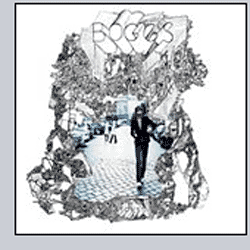 by: Sam Farzin
by: Sam Farzin
When you go to see a band, it’s almost a given that you’ll have to sit through some opening acts: friends of the headliner, another band packaged along by the tour promoter, or perhaps a lucky, somewhat arbitrary local band. These artists are often put to the most rigid and unforgiving test by the disinterested, impatient audience members. These are people, who, probably weak-legged and even irritable from hours of standing, are waiting only to see the band they bought a ticket to for; they don’t know your songs, they don’t know who you are, and they very well might not care. It’s kind of a harsh, but given, truth, by and large.
My first experience with Jason Friedman and his Boggs’ music was as one of these audience members. A tall and lanky twentysomething walked out on stage with an acoustic guitar, introducing himself as “Jason.” Dressed in a very neutral palette, without any preconceptions, bias, or real warning, he began to play: his manner was, at first, calm and with a steady resolve; but then it transformed, as if he mentally snapped, escalating very quickly into a frenetic assault. This assault was a constant through the majority of his half hour set. He tore up and down his acoustic Martin, creating an acoustic wall-of-noise augmented constantly with various pedals. Jaws agape, the audience, myself very much included, watched on as this enigmatic individual blistered his fingers and broke strings, changing his steadfast concentration only to sing, his eyes wide and glaring straight back through the venue, as if possessed. A reserved “thanks” marked the end of his set.
Fast-forward to now. Friedman’s band, the constantly-evolving Boggs, have just put out their third record, Forts, some two years in the making. Essentially Friedman’s vision, the Boggs feature a revolving line-up of players that include folks from Au Revoir Simone, Enon, Liars, and other worthy, likeminded folks.
Forts is built intensely like its namesake. The supports are mounted too tightly to the ceilings, and the pressure is building; the floorboards are being pulled up and their screws are unthreading. Just before everything just falls apart into itself, just as the strain is seemingly relaxed, we move onto the next track and the whole process starts over.
Throughout the album we are brought back to this image, starting at the beginning: the title track sets us up with click-clack glitch percussion leading into bright left-channel acoustic guitar, layered, mounting bass, electric guitar rhythms, and shouted, pervasive vocals wrought with imagery. “Remember the Orphans”, follows, taking cues from the first track, building faster and harder: it comes out relentless, with pounding drums frenetic boy-girl vocals, angular guitars paired with rolling basslines all tossed together. The record’s songs do not overstay their welcome, leaving their mark without a lot of unnecessary clutter and fluff.
On Forts, Friedman has nailed down an elastic sound that, throughout the course of the record, is twisted, bent, grated, and trampled but bounces back to a cohesive whole: violins and brass mix with rolling hills of toms and buzzsaw guitar. Relatively downtempo numbers strewn across the album tie the album's recurring themes of frenzied suspense and uncertainty with the in-the-red, overdriven tracks toward end. The taut net of the album is strengthened by the parallels Friedman is able to draw out of disparate songs: the frolicking, summer prettiness of "Little Windows" at the beginning and the rhythmic, almost ethnic drive of "Melanie in the White Coat" near the end are such differently crafted sounds yet both songs retain the aural notion of being part of Forts in sequence, structure, and holistic sonic density.
Sure, Forts is indie rock or whatever. There’s really a hell of a lot more to it than that, though; the album has been fleshed out so calculatedly that it is hard to find a lot of flaws. It is overtly clear that Friedman and his friends experimented heavily in the blueprinting of the record, adding and subtracting, testing and recording until achieving the exact balance of instrumentation and noise necessary to hold the record together. Forts’ unmistakable sense of urgency coupled with a total kitchensink approach to recording feels so fresh and overwhelmingly together that I wouldn’t be surprised to see this crop up later in the year as a sleeper hit. Forts can take a while to build.
Share
|
|

